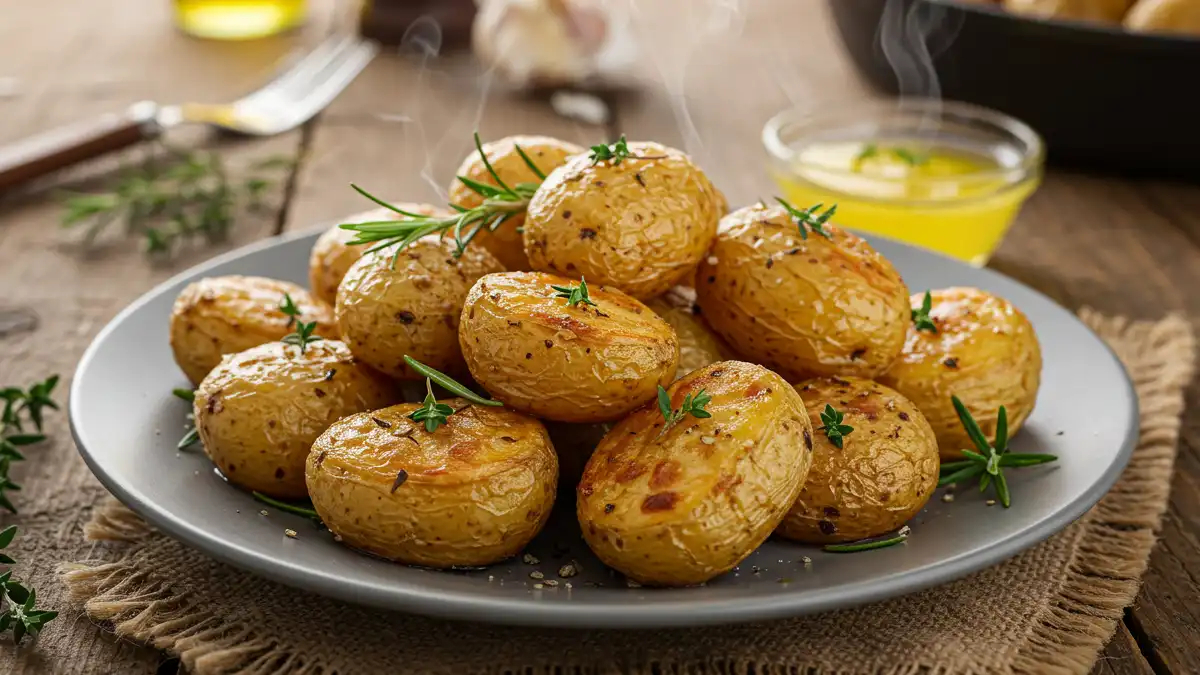
Table of Contents
Nothing captivates the senses quite like a beautifully prepared dish, and marble potatoes have the power to transform any meal into a showstopping experience. These tiny, colorful gems are packed with flavor, offering a crispy, golden-brown exterior and a soft, creamy center that melts in your mouth. Whether you’re planning a cozy dinner, a holiday gathering, or an elegant feast, marble potatoes bring sophistication, taste, and texture to the table.
If you’re looking to impress your guests effortlessly, these five irresistible recipes will elevate your cooking game and turn simple potatoes into culinary masterpieces.
1. Garlic Butter Roasted Marble Potatoes
Crispy Perfection with a Buttery, Savory Kick
Few things rival the irresistible aroma of garlic butter roasted potatoes fresh out of the oven. This method ensures perfect crispiness, locking in the rich, buttery flavor that makes every bite unforgettable.
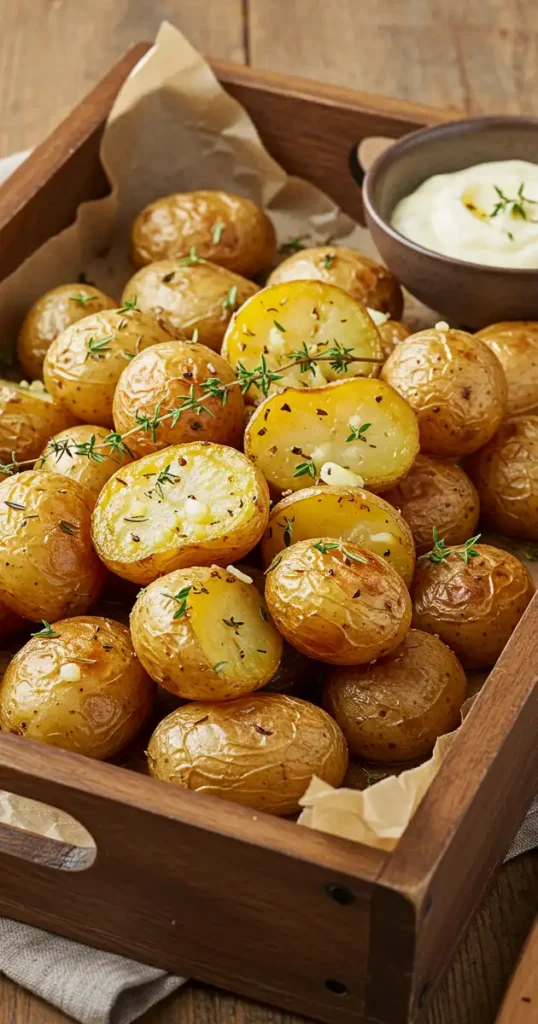
Ingredients:
- 1.5 lbs marble potatoes, halved
- 3 tbsp unsalted butter, melted
- 3 cloves garlic, minced
- 1 tsp salt
- ½ tsp black pepper
- 1 tsp fresh thyme leaves
- 1 tbsp olive oil
Instructions:
- Preheat the oven to 425°F (218°C).
- In a bowl, toss the halved marble potatoes with melted butter, garlic, thyme, salt, and black pepper until evenly coated.
- Spread them on a baking sheet in a single layer, cut side down for maximum crispiness.
- Roast for 25-30 minutes, flipping once halfway through.
- Remove from the oven and garnish with fresh parsley or grated Parmesan cheese.
🔹 Best Served With: A juicy steak, roasted chicken, or grilled salmon.
2. Crispy Parmesan Herb Potatoes
Golden, Crunchy, and Packed with Flavor
For those who crave a crispy texture with a cheesy twist, these Parmesan herb potatoes are a game-changer. The golden crust of Parmesan cheese creates a delightful crunch, while the inside remains soft and fluffy.
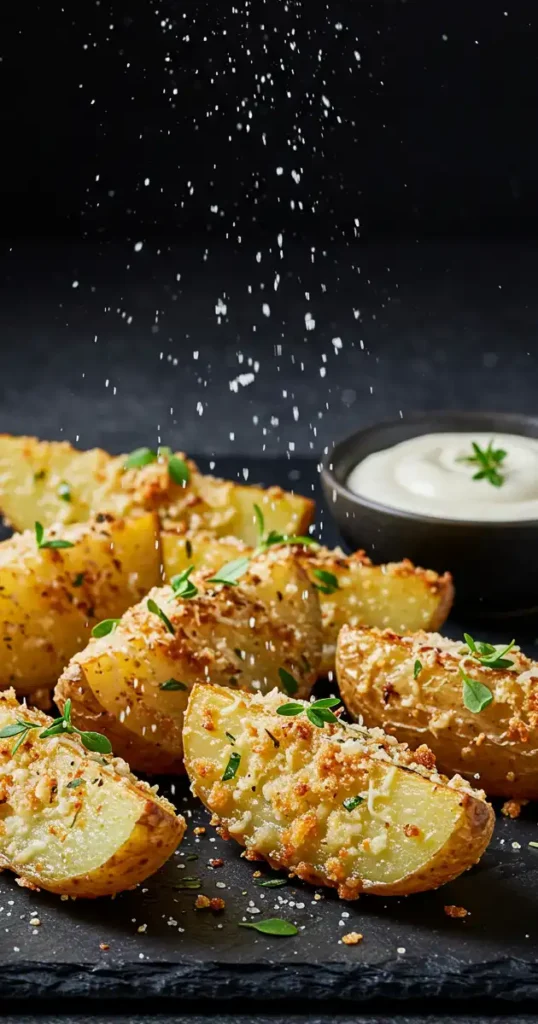
Ingredients:
- 1.5 lbs marble potatoes, halved
- ¼ cup grated Parmesan cheese
- 2 tbsp olive oil
- 1 tsp garlic powder
- 1 tsp Italian seasoning
- Salt and black pepper to taste
Instructions:
- Preheat the oven to 400°F (200°C).
- Toss the halved potatoes with olive oil, garlic powder, Italian seasoning, salt, and pepper.
- Sprinkle grated Parmesan on a baking sheet and place the potatoes cut side down on top.
- Roast for 25 minutes until the cheese forms a crispy crust.
- Let them cool slightly before serving to maintain the crunch.
🔹 Best Served With: Roasted vegetables, grilled chicken, or a tangy yogurt dipping sauce.
3. Skillet Sautéed Marble Potatoes with Rosemary
Pan-Seared Goodness with a Fragrant Herbal Touch
If you’re short on time but still want a dish that feels gourmet, try skillet-sautéed marble potatoes. Cooking them in a hot pan allows them to develop a golden crust while keeping the inside buttery and tender.
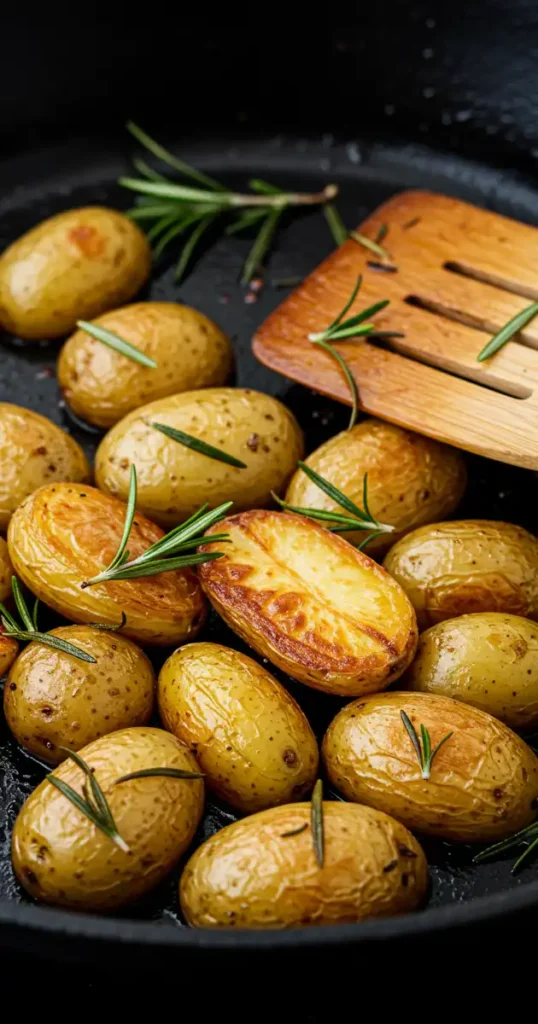
Ingredients:
- 1 lb marble potatoes, halved
- 2 tbsp olive oil
- 1 tbsp unsalted butter
- 1 tsp fresh rosemary, chopped
- Salt and black pepper to taste
Instructions:
- Heat olive oil in a large skillet over medium heat.
- Add the potatoes in a single layer and cook for 5 minutes without stirring.
- Stir occasionally and cook for another 10 minutes until crispy and golden brown.
- Add butter, rosemary, salt, and pepper, tossing to coat.
- Serve hot, garnished with extra herbs if desired.
🔹 Best Served With: Grilled fish, seared steak, or creamy dipping sauces.
4. Creamy Garlic Mashed Marble Potatoes
A Silky, Comforting Take on a Classic Dish
For a dish that warms the soul, creamy garlic mashed marble potatoes are a must. These buttery, velvety potatoes are smooth, rich, and bursting with garlic-infused flavor.
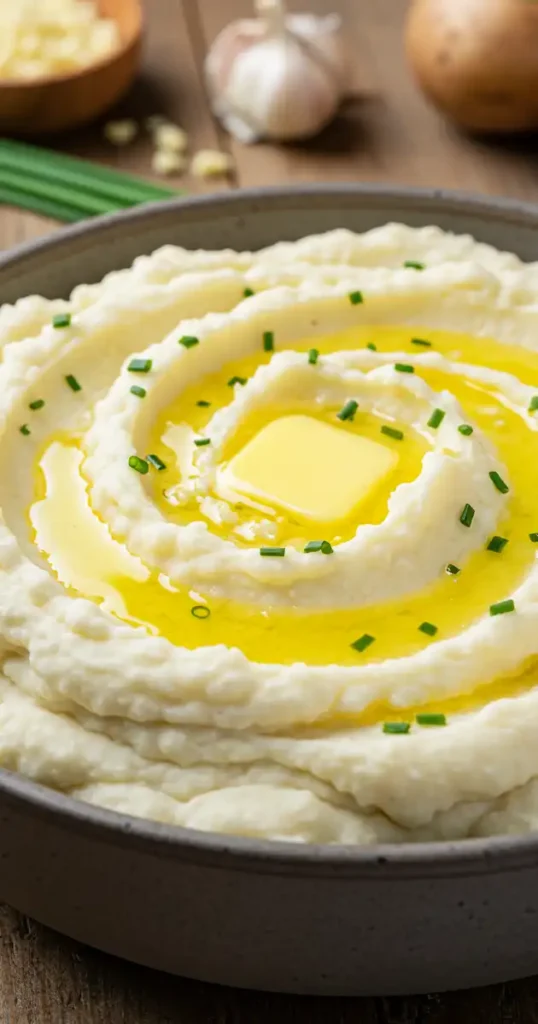
Ingredients:
- 1.5 lbs marble potatoes, boiled
- 3 tbsp unsalted butter
- ½ cup heavy cream (or milk substitute)
- 2 cloves garlic, minced
- Salt and black pepper to taste
Instructions:
- Boil the potatoes until fork-tender, about 15 minutes.
- Drain and mash with butter, warm heavy cream, and garlic.
- Add salt and pepper to taste, stirring until smooth.
- Garnish with chopped chives or freshly grated Parmesan cheese.
🔹 Best Served With: Roast beef, braised short ribs, or baked chicken.
5. Lemon & Herb Potato Salad (No Mayo!)
A Light, Refreshing, and Zesty Side Dish
For a healthier, Mediterranean-inspired take on potato salad, this lemon & herb version is vibrant and packed with fresh flavors.
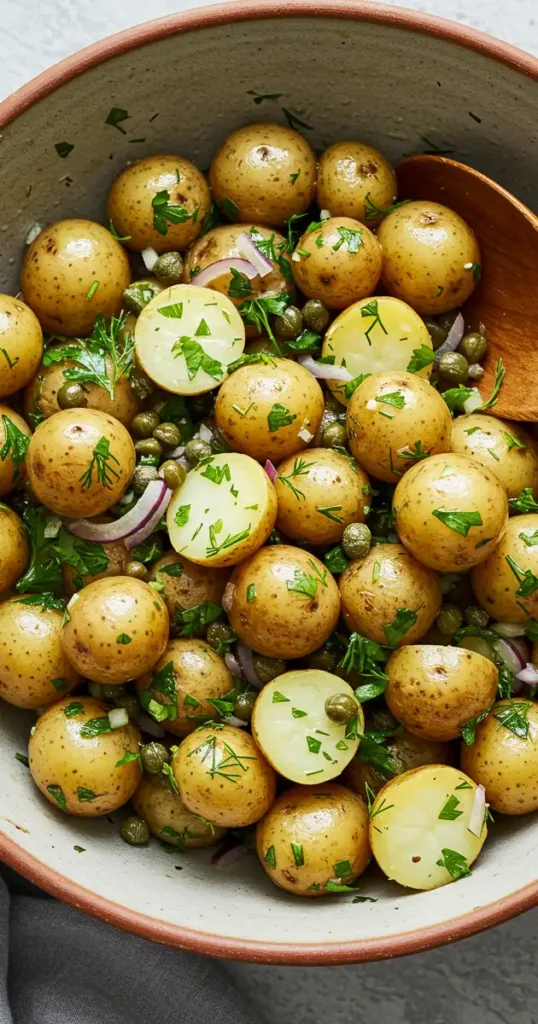
Ingredients:
- 1 lb marble potatoes, boiled and halved
- ¼ cup olive oil
- 2 tbsp fresh lemon juice
- 1 tsp Dijon mustard
- ¼ cup chopped fresh dill or parsley
- Salt and black pepper to taste
Instructions:
- Boil the marble potatoes until fork-tender, then drain and let cool.
- In a small bowl, whisk together olive oil, lemon juice, Dijon mustard, salt, and pepper.
- Toss the potatoes with the dressing and fresh herbs.
- Let sit for 15 minutes before serving to allow the flavors to meld.
🔹 Best Served With: Grilled seafood, BBQ meats, or as a light picnic dish.
Conclusion: Elevate Any Meal with Marble Potatoes
Marble potatoes may be small, but their flavor, texture, and versatility make them a powerful ingredient in any kitchen. Whether roasted, sautéed, mashed, or used in salads, they always deliver a mouthwatering experience that impresses guests and satisfies cravings.
Try one (or all) of these five incredible recipes and turn a simple ingredient into a gourmet masterpiece!
The Untold Story of Marble Potatoes: A Culinary Legacy of Resilience and Tradition
There’s something magical about a simple dish that connects generations, weaving together history, culture, and the art of home cooking. The story of marble potatoes is one of resilience, ingenuity, and the power of food to bring people together.
As Americans gather around their tables today, savoring a plate of crispy, golden-brown marble potatoes, they might not realize that these tiny gems have a story stretching back centuries—one filled with hardship, perseverance, and an enduring love for good food.
A Potato That Traveled the World
Long before they became a beloved side dish in American kitchens, marble potatoes had already made an incredible journey. Their roots trace back to the Andean mountains of South America, where indigenous farmers cultivated hundreds of potato varieties as early as 8,000 years ago. These early farmers, despite facing unforgiving climates and harsh terrains, learned to adapt, selectively breeding potatoes that could withstand the elements.
When Spanish explorers set sail in the 16th century, they carried potatoes across the Atlantic, introducing them to Europe. At first, Europeans were skeptical—some even believed potatoes were poisonous! But over time, people discovered their nutritional value, resilience, and versatility, and the humble potato became a staple food for survival.
The Role of Marble Potatoes in Early America
By the time potatoes arrived in North America, they were already feeding ntire nations. However, it was the Irish immigrants of the 18th and 19th centuries who brought a special connection to these tiny tubers. Fleeing famine and hardship, many Irish families carried potato seeds with them as they sought a better life in the New World.
Marble potatoes, with their small, hearty nature and ability to grow in various climates, became a lifeline for struggling settlers. Families who had little else learned to roast, boil, and mash these tiny potatoes, creating simple yet nourishing meals that kept them strong through hard times.
During the Great Depression, when millions of Americans faced food shortages, marble potatoes once again proved their worth. Families stretched their limited resources by incorporating potatoes into every meal, using them to make soups, stews, and roasted dishes that provided both comfort and sustenance.
The American Love Affair with Comfort Food
Fast forward to today, and marble potatoes have become a cherished ingredient in American homes. No longer just a food of necessity, they now symbolize something much greater—a reminder that even in the toughest times, a simple meal can bring people together and nourish the soul.
Think about it: What’s more American than gathering around a table with loved ones, sharing a warm, home-cooked meal? From Thanksgiving feasts to summer barbecues, from Sunday family dinners to elegant dinner parties, marble potatoes have remained a timeless favorite.
As chefs and home cooks experiment with flavors, we see these once-humble potatoes elevated into gourmet dishes—roasted with garlic butter, infused with rosemary, tossed with Parmesan, or turned into creamy mashed perfection. But no matter how they’re prepared, one thing remains the same:
Marble potatoes are a symbol of resilience, tradition, and the universal love of good food.
Why This Story Matters to You
Next time you prepare a batch of crispy, golden marble potatoes, remember that you’re not just making a dish—you’re carrying on a legacy of survival, creativity, and culinary excellence.
You’re honoring the farmers who first cultivated them, the explorers who carried them across oceans, the immigrants who planted them in American soil, and the families who found comfort in their warmth during tough times.
So as you take that first delicious bite, let it be a reminder: Food is more than sustenance—it’s history, culture, and the heart of every home.
And in that moment, as the buttery richness melts in your mouth, you’ll know—you’re not just eating marble potatoes.
You’re tasting history.
FAQs
1. Is potato marble healthy?
Marble potatoes are healthy in moderation. They are rich in vitamins, minerals, and fiber, and are a good source of antioxidants. However, like all potatoes, it's important to balance them with other vegetables and not overcook them, as they can lose some nutrients when fried or cooked with excessive butter or cream.
2. How long do you cook marble potatoes for?
The cooking time for marble potatoes depends on the cooking method. Generally, they take about 15-20 minutes to boil or steam until tender. If roasting, it usually takes about 25-35 minutes at 400°F (200°C). You can also adjust the cooking time depending on their size and how crispy or tender you want them.
3. Why are scalloped potatoes called funeral potatoes?
Scalloped potatoes are often called "funeral potatoes" in some regions due to their association with church gatherings or post-funeral meals. This comfort food is commonly prepared for large groups at these events, offering a warm and hearty dish to share during emotional times.
4. What is the healthiest potato?
The healthiest type of potato is generally the sweet potato. It’s packed with nutrients like fiber, vitamin A, and antioxidants. Among regular potatoes, red potatoes and Yukon Gold potatoes are considered healthier choices compared to varieties like russets because they have thinner skins, which retain more nutrients.
5. What is the most expensive type of potato?
The La Bonnotte potato is considered the most expensive potato in the world. Grown on a small French island, it’s extremely rare and can cost up to $500 per kilogram due to the labor-intensive cultivation process and its limited availability.
6. What is the best tasting potato to grow?
The Yukon Gold potato is often considered one of the best-tasting potatoes to grow. It has a rich, buttery flavor and a creamy texture, making it ideal for mashed potatoes, roasting, and other dishes. Additionally, fingerling potatoes are also highly regarded for their unique flavor and versatility.
7. What potatoes does Gordon Ramsay use?
Gordon Ramsay is known to use Yukon Gold potatoes in many of his dishes due to their smooth texture and rich, buttery taste. He also appreciates the versatility of Maris Piper potatoes, especially for making crispy fries or mashed potatoes.